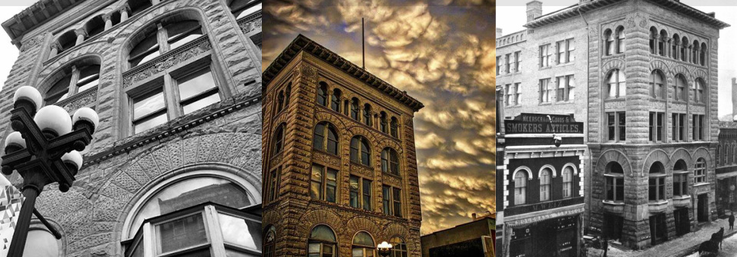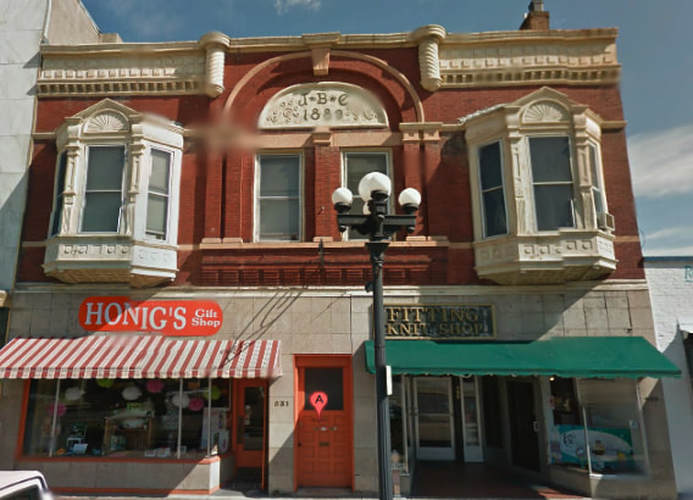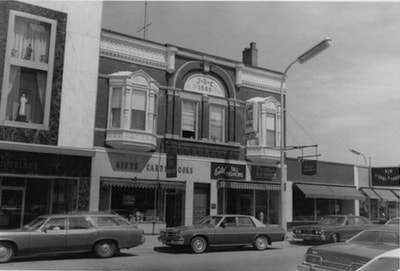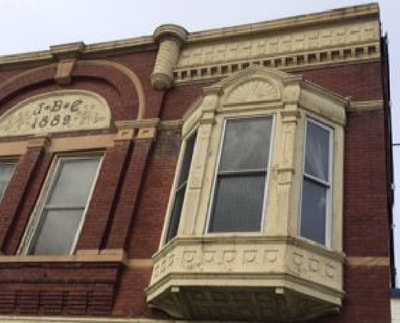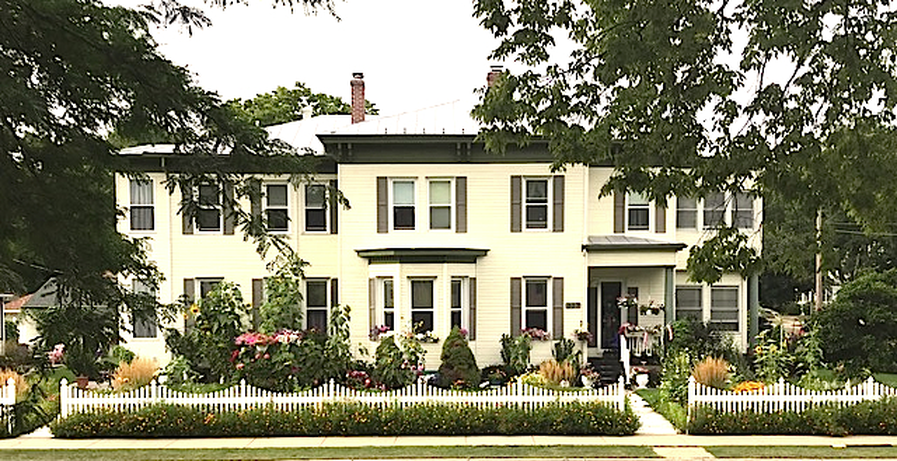The Batavian Building, 1888
Built in 1888, the Batavian Building is a historic office building located at 319 Main Street in the LaCrosse Commercial Historic District. The Batavian Building is on the National Register of Historic Places, as well as The Downtown Historic Commercial District. Our Vision is that the Batavian Building will be a vibrant, historic building in the downtown commercial district that provides a diverse, user-friendly environment for residents, businesses and visitors. The Batavian Building will be a destination location for residential life, commercialism and tourism.
CLICK HERE to go to the BATAVIAN BUILDING website!
CLICK HERE to go to the BATAVIAN BUILDING website!
The J.B. Canterbury Building, 1899
531-535 Main Street, La Crosse, WI 54601
Of rather eclectic design, the Canterbury Building features a metal Italianate cornice and frieze over a brick facade articulated by a Romanesque blind round arch supported by short small chopped brick piers over paired windows, small pedimented gable roofs over a pair of three sided oriel windows in the end bays of the upper, and is one of the few buildings in the city that has retained its second story bay windows; white stone belt courses and decoration brick work under the center windows further articulate the surface.
Store fronts have been altered for contemporary commercial use. Constructed in 1889 by J.B. Canterbury, a real estate dealer as an investment, the J.B. Canterbury building is significant to the architectural variety of La Crosse as an example of the rampant eclecticism commonly found in commercial architecture during the late 19th century.
The building was originally designed with two, mirror image apartments on the 2nd floor, and two retail spaces on the main floor (533 and 535 Main Street).In 1972, the east retail spot was split into two, with one of the two being larger. At that time, the address changed to include 531 Main Street.
Built by A. Johnson in 1889, alterations and additions were added in 1947, by Architect Frank Fuchs; he added Winona stone and glass windows to the storefront and another alteration was done in 1972 when a third retail space was added to the building.
Of rather eclectic design, the Canterbury Building features a metal Italianate cornice and frieze over a brick facade articulated by a Romanesque blind round arch supported by short small chopped brick piers over paired windows, small pedimented gable roofs over a pair of three sided oriel windows in the end bays of the upper, and is one of the few buildings in the city that has retained its second story bay windows; white stone belt courses and decoration brick work under the center windows further articulate the surface.
Store fronts have been altered for contemporary commercial use. Constructed in 1889 by J.B. Canterbury, a real estate dealer as an investment, the J.B. Canterbury building is significant to the architectural variety of La Crosse as an example of the rampant eclecticism commonly found in commercial architecture during the late 19th century.
The building was originally designed with two, mirror image apartments on the 2nd floor, and two retail spaces on the main floor (533 and 535 Main Street).In 1972, the east retail spot was split into two, with one of the two being larger. At that time, the address changed to include 531 Main Street.
Built by A. Johnson in 1889, alterations and additions were added in 1947, by Architect Frank Fuchs; he added Winona stone and glass windows to the storefront and another alteration was done in 1972 when a third retail space was added to the building.
The W.W. Withee House, 1897
1434 Cass Street, La CrosSe, WI 54601
Constructed in 1897 for W.W. Withee, a La Crosse lumberman and president of the Security Savings Bank, the Withee House is a significant example of one of the few brick interpretations of the Queen Anne style and is one of the few remaining well preserved mansions built by the lumber barons who made La Crosse history. Even though considered Queen Anne Style, it is unusual because of the use of exterior patterned masonry. In fact, because of the stonework, the Withee House could be one of the few existing examples remaining in the country. The interior of the home was decorated with solid oak woodwork throughout, and the original home included a bowling alley in the basement (which still exisits) and a ballroom on the third floor. Withee was a La Crosse businessman and son of Nyram (Niran) Withee. To go to our Withee House website, CLICK HERE.
The Cargill-Pettibone House
145 8th Street South, La Crosse, WI 54601
The Cargill-Pettibone House at 145 South 8th Street, is of the French Second Empire style. with characteristic mansard roof, decorative classical details and original brick surface of the exterior (painted). The Cargill-Pettibone House, although in poor repair and altered with the addition of the enclosed porches, is one of the two architecturally significant representatives of the French Second Empire style in the City of La Crosse.
Built in 1876 by Henry Esperson (who never lived there) the home is of the French Second Empire Style. The French Second Empire style, featuring a characteristic dominant mansard roof, was the rage during the 1870’s. The Second Empire style, developed in France during the 1850’s, provided a way whereby one could continue the classical tradition of balance and control while presenting a picturesque appearance. The Cargill-Pettibone House is one of the two architecturally significant representatives of the French Second Empire style in the City of La Crosse.
The house was occupied by W.W. Cargill, local grain merchant for six years, from 1878 through 1884. William Wallace Cargill, of the world recognized company got his start at the close of the American Civil War in 1865 with one grain storage warehouse in Conover, Iowa. Cargill followed the expansion of the railroad system throughout the newly settled prairie to gather and process grain. Soon, his two brothers, Sam and James, joined his business venture and established the company's headquarters in La Crosse, Wisconsin.
A. W. Pettibone purchased and moved into the home in 1884. A. W. Pettibone was a prominent local lumberman and donor of the Pettibone Park; he was one of the leading lumber merchants of the era in the industry. A. W. Pettibone resided in the house from 1884 until his death in 1915. Albert W. Pettibone, donor of the Pettibone Park, was one of the leading lumber merchants of the era in the industry. Mr. Pettibone was three times elected mayor of the city, in 1862, 1863 and 1864; he died in 1915, and his funeral was held in the home on August 4, 1915 … he was 88 years old. Mr. Pettibone was married to Mrs. Cordelia (Wilson) Pettibone.
The Cargill-Pettibone House is our newest project, and will be restored to a single-family residence (from a quad-plex). Restoration is scheduled to be complete in April of 2016. Read more about the Cargill-Pettibone House by CLICKING HERE, or going to our website by CLICKING HERE.
Built in 1876 by Henry Esperson (who never lived there) the home is of the French Second Empire Style. The French Second Empire style, featuring a characteristic dominant mansard roof, was the rage during the 1870’s. The Second Empire style, developed in France during the 1850’s, provided a way whereby one could continue the classical tradition of balance and control while presenting a picturesque appearance. The Cargill-Pettibone House is one of the two architecturally significant representatives of the French Second Empire style in the City of La Crosse.
The house was occupied by W.W. Cargill, local grain merchant for six years, from 1878 through 1884. William Wallace Cargill, of the world recognized company got his start at the close of the American Civil War in 1865 with one grain storage warehouse in Conover, Iowa. Cargill followed the expansion of the railroad system throughout the newly settled prairie to gather and process grain. Soon, his two brothers, Sam and James, joined his business venture and established the company's headquarters in La Crosse, Wisconsin.
A. W. Pettibone purchased and moved into the home in 1884. A. W. Pettibone was a prominent local lumberman and donor of the Pettibone Park; he was one of the leading lumber merchants of the era in the industry. A. W. Pettibone resided in the house from 1884 until his death in 1915. Albert W. Pettibone, donor of the Pettibone Park, was one of the leading lumber merchants of the era in the industry. Mr. Pettibone was three times elected mayor of the city, in 1862, 1863 and 1864; he died in 1915, and his funeral was held in the home on August 4, 1915 … he was 88 years old. Mr. Pettibone was married to Mrs. Cordelia (Wilson) Pettibone.
The Cargill-Pettibone House is our newest project, and will be restored to a single-family residence (from a quad-plex). Restoration is scheduled to be complete in April of 2016. Read more about the Cargill-Pettibone House by CLICKING HERE, or going to our website by CLICKING HERE.
The Montague House
238 10th Street South, La Crosse, WI 54601
1874
Giles R. Montague planted his roots here in 1854, moving from Granby, Massachusetts. Considered one of the oldest residents of La Crosse, Mr. Montague was a prominent businessman who encouraged development in the community. His early businesses encompassed insurance, surveying, and real estate.
In 1894, he opened the La Crosse Cracker and Candy Company, where his wholesale goods were transported across the Midwest.
After five short years Mr. Montague sold the factory to well-known Nabisco. Nabisco operated the La Crosse factory until 1904, when they announced they would be closing the plant and moving operations to the Twin Cities. The people of La Crosse were not impressed with Nabisco’s decision. Community members, feeling glum and hurt by the loss of jobs, rallied around Mr. Montague to purchase the company back. In 1905, he regained ownership of the factory and expanded operations.
In 1894, he opened the La Crosse Cracker and Candy Company, where his wholesale goods were transported across the Midwest.
After five short years Mr. Montague sold the factory to well-known Nabisco. Nabisco operated the La Crosse factory until 1904, when they announced they would be closing the plant and moving operations to the Twin Cities. The people of La Crosse were not impressed with Nabisco’s decision. Community members, feeling glum and hurt by the loss of jobs, rallied around Mr. Montague to purchase the company back. In 1905, he regained ownership of the factory and expanded operations.
